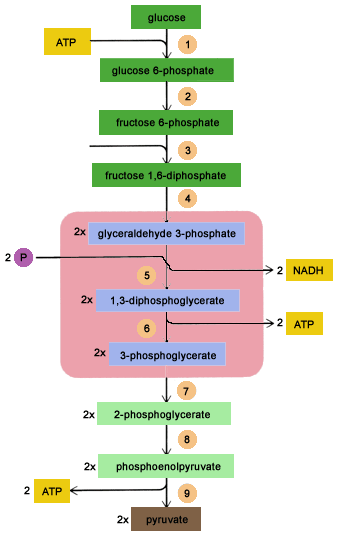Biology
Glycolysis can be a pretty daunting concept to really get a firm understanding on, with so many different molecule derivatives involved. So here, I will be explaining this process in a step-by-step manner that hopefully, will help alleviate any frustrations. The main function of the glycolysis pathway, which occurs in the cytoplasm of cells, is to break down glucose into two 3-carbon molecules of pyruvate.
GLYCOLYTIC PATHWAY (STEP-BY-STEP)

Please feel free to leave comments to let me know if you thought this blog was useful or if there is anything that I can improve upon. Thanks!
- Krebs Cycle Broken Down
The Krebs cycle, also known as the Citric Acid cycle, is a very important process in cellular respiration. Without this portion, respiration would not be possible. This is because the Krebs cycle uses the pyruvate molecules from glycolysis to produce...
- Respiration
Respiration is the breakdown of large glucose molecules into simple molecules such as carbon dioxide and water with the simultaneous release of energy inside living cells. It is an enzyme mediated process. Main processes: Glycolysis (glucose to pyruvate,...
- Q: Outline The Main Features Of A Krebs Cycle
The Krebs cycle occurs in the matrix of the mitochondrion. It occurs only in aerobic conditions, that is, only when oxygen is present. Its main function is to oxidise acetyl CoA generated from glycolysis. In the Krebs cycle, acetyl CoA and oxaloacetate...
- #87 Respiration, Glycolysis
Respiration is the oxidation of energy-containing organic molecules. The energy released from this process is used to combine ADP with inorganic phosphate to make ATP. All cells obtain useable energy through respiration. Most cells use carbohydrate,...
- Q & A
Questions Plants derive energy from the _____________ of Glucose into __________. The time in which a cell oxidizes glucose is known as______. The oxidation of glucose into pyruvate is a process known as__________. What is the energy released during glycolysis...
Biology
Glycolysis Broken Down
Glycolysis can be a pretty daunting concept to really get a firm understanding on, with so many different molecule derivatives involved. So here, I will be explaining this process in a step-by-step manner that hopefully, will help alleviate any frustrations. The main function of the glycolysis pathway, which occurs in the cytoplasm of cells, is to break down glucose into two 3-carbon molecules of pyruvate.
GLYCOLYTIC PATHWAY (STEP-BY-STEP)
- Initially, Glucose (STARTING PRODUCT) is phosphorylated (given a molecule of phosphate) by ATP with the help of hexokinase (enzyme that facilitates phosphorylation), leading to the molecule, Glucose 6-phosphate.
- Glucose 6-phosphate is rearranged by an enzyme known as Phosphoglucose isomerase, leading to the molecule Fructose 6-phosphate.
- Following another phosphorylation, this time by the molecule Phosphofructokinase, Fructose 6-phosphate turns into Fructose 1,6-biphosphate.
- The 6 carbon molecule, Fructose 1,6-biphosphate is split into two 3-carbon molecules by an enzyme simply called an Isomerase. The resulting 2 molecules are as follows -- Dihydroxyacetone phosphate and Glyceraldehyde 3-phosphate (G3P). -- For the sake of keeping things simple, we are not going to worry about the Dihydroxyacetone phosphate because it is converted into G3P later in another reaction.
- With that being said, we are left with one molecule to deal with (G3P), which undergoes oxidation, followed by yet another phosphorylation. This leads to the production of two NADH molecules, as well as, two 1,3-Bisphosphoglycerate (BPG) molecules. These reactions occur as a result of the enzyme, Glyceraldehyde 3-phosphate dehydrogenase.
- Next, the enzyme phosphoglycerate kinase facilitates the removal of phosphate molecules by ADP, resulting in two molecules of 3-Phosphoglycerate (3PG).
- Conversion of 3PG by Phosphoglyceromutase, converts the 3PG into 2-Phosphoglycerate (2PG).
- The enzyme Enolase removes a water molecule (H2O) from each 2PG molecule forming two Phosphoenolpyruvate (PEP) molecules.
- Finally, Pyruvate kinase facilitates the removal of two more phosphate molecules from PEP, producing two ATP molecules and two Pyruvate molecules (END PRODUCT).
FOLLOW THE CHART BELOW FOR AN OVERVIEW OF EACH MOLECULE. THIS PICTURE DOES NOT SHOW THE ENZYMES ASSOCIATED WITH EACH STEP; HOWEVER, THESE ARE MENTIONED ABOVE.

Please feel free to leave comments to let me know if you thought this blog was useful or if there is anything that I can improve upon. Thanks!
- Krebs Cycle Broken Down
The Krebs cycle, also known as the Citric Acid cycle, is a very important process in cellular respiration. Without this portion, respiration would not be possible. This is because the Krebs cycle uses the pyruvate molecules from glycolysis to produce...
- Respiration
Respiration is the breakdown of large glucose molecules into simple molecules such as carbon dioxide and water with the simultaneous release of energy inside living cells. It is an enzyme mediated process. Main processes: Glycolysis (glucose to pyruvate,...
- Q: Outline The Main Features Of A Krebs Cycle
The Krebs cycle occurs in the matrix of the mitochondrion. It occurs only in aerobic conditions, that is, only when oxygen is present. Its main function is to oxidise acetyl CoA generated from glycolysis. In the Krebs cycle, acetyl CoA and oxaloacetate...
- #87 Respiration, Glycolysis
Respiration is the oxidation of energy-containing organic molecules. The energy released from this process is used to combine ADP with inorganic phosphate to make ATP. All cells obtain useable energy through respiration. Most cells use carbohydrate,...
- Q & A
Questions Plants derive energy from the _____________ of Glucose into __________. The time in which a cell oxidizes glucose is known as______. The oxidation of glucose into pyruvate is a process known as__________. What is the energy released during glycolysis...
